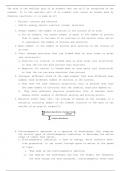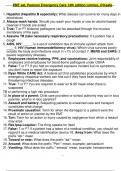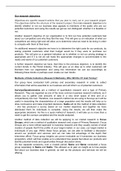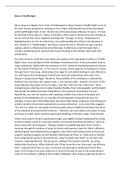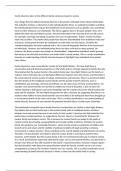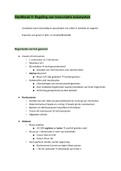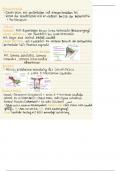Isabelle Lane
Unit 7: Principles of safe practice in Health and Social Care
P1 - Explain the implications of a duty of care in a selected health or social care setting
M1 - Assess the importance of balancing individual rights with a duty of care in selected health
and social care settings.
In this piece of coursework I have chosen to study Case study 2: Wellings NHS trust, ward 3B,
which is a surgical ward for females. In this ward there is a team consisting of registered nurses,
nursing associates and healthcare assistants. There are a few faults with the ward, including
that the keypad which allows access in and out is out of order, meaning that the door is
constantly propped open, which allows unauthorised people to enter. In this ward individual’s
are able to undergo planned and emergency procedures, whilst also allowing a place for
recovery. One of the current patients on the ward is Lizzie, Lizzie had a routine procedure on
her hand , which went really well, with no complications.
Duty of care is a moral or legal obligation to ensure the safety or well being of others. Anyone
working in a health and social care career should know how and when to exercise this practice,
the duty of care is all about being responsible for that person such as keeping them safe,
looking after them, ensuring that the individual is out of danger or potential harm. The nurse and
ward manager have a duty of care towards Lizzie to make sure she is being safeguarded and
protected as well as, providing her with the highest quality of care possible.
It is really important that healthcare professionals try to form a relationship with the patients that
they are working with, as it is able to promote a more positive type of care. Having a secure
bond and trust formed between the patient and the professional is really beneficial for both
individuals, as they are able to share information with each other more effectively. However
because of this, it is important that boundaries are put in place to ensure that both the patient
and the healthcare professional are safe. An example of this could be that the healthcare
professional is not allowed to discuss their private life with their patient, or are unable to provide
any additional favours for their patients. Similarly, the professional should ensure that no private
information including contact numbers and addresses or social media is shared. This allows the
professional to be kept safe and protected. It is vital to make sure that boundaries are set
between a healthcare professional and the patient, such as ensuring that gifts shouldn’t be
exchanged between each other, inappropriate details such as personal home addresses,
agreeing to socialise outside of the service, breaching confidentiality, inappropriate sexual
contact, completing tasks for the patient with your own money, verbal aggression and not
documenting relevant patient information such as their medication. These are all examples of
boundaries which should not be crossed by both the patient and the professional, as this is not
a respectful or professional relationship. These boundaries are in place to uphold both the legal
and the ethical standards that all healthcare professionals should follow, which are set by the
national code of conduct of healthcare workers. These boundaries set the ethical guidelines
which ensure the facility is maintaining sufficient training and professionalism. It is important for
the service user and the professional to maintain a professional relationship in order to prevent
any emotions affecting the professional's decisions with the patient's care.
1
,Isabelle Lane
In my case study which I have chosen at Wellings NHS trust, ward 3B. This setting is a hospital,
and all of these boundaries must be upheld to ensure that a professional and respectful
relationship is maintained. The relationship between Lizzie, her nurse and the manager of the
ward is strictly professional, they have never shared personal information about each other and
have not bought each other gifts for example. However there is a possibility that their
relationship may be considered as unprofessional when talking about Lizzie’s medication, they
are not looking after her medication that well and I’m not recording it, which could put Lizzie at
risk. They seem to be giving Lizzie medication whenever she mentions that she is in pain,
although this can probably be seen as a good duty of care as they are listening to her needs
and providing medication, it is also able to be seen as a breach between a professional
relationship, as they are feeling bad that she is in pain. When prescribing her with more pain
relief nurses aren’t checking whether she had already been given her set dosage, which could
result in an overdose. However in order for the nurse in manager to provide the best care for
Lizzie, it’s better that the relationship is professional, the relationship between Lizzie, the nurse
and the manager overall would be seen as professional, this helps and provide a good duty of
care for Lizzie.
Abuse and neglect is something that is very important to be prevented to protect patients from in
a healthcare setting. It is crucial that all patients are safeguarded away from people who may
potentially be abusing and neglecting them, this is to keep them safe and out of harm's way.
There are certain signs that a healthcare professional would be able to look out for when
identifying whether a patient is being abused or not. Please can be seen or noticed by a patient
becoming quiet or standoffish, the character may change such as becoming quiet or upset,
physical signs such as bruising and wounds as well as injuries, wanting to be alone or not
wanting to be alone, a reoccurring injury in the same place happening more than once. These
are all signs for a professional to consider that the patient is receiving abuse. Every healthcare
professional within the setting should ensure that they have their best interests when helping
their patients get better or to find help. Professionals should intervene in a patient’s business if
they see signs of abuse or neglect occurring, this is to help protect the patient and keep them
safe, this could be done through taking responsibility of stepping forward as their advocate, and
allowing the individual to have a voice. In relation to safeguarding, the nurse and the manager
I’m not upholding Lizzie’s right to a good duty of care. As previously mentioned the doors on the
ward which Lizzie is on have been broken and out of order for a while, whilst also seeming as
though they won’t be getting fixed any time soon. Due to the fact that the doors which are
usually keypad accessible only broken, this means that anyone unauthorised is able to reach
Lizzie, this puts her safety at risk and emphasises the fact that she is not safe in the care of the
professionals. Because the nurses are not rushing to get the broken doors fixed, this becomes a
breach in Lizzie’s rights and the nurses are not upholding a good duty of care because they are
putting her at risk of being harmed.
Professionals protect an individual's health, safety and wellbeing in many different ways. For
example, by adhering to policies and procedures and following the Health and Safety at Work
Act 1974. The Health and Safety at Work Act 1974 places responsibilities on employers as well
2
,Isabelle Lane
as employees. Employers have to make sure that they take reasonable steps to maintain the
health and safety of their employees as well as patients and visitors. The role of the employee is
to cooperate with the employer in relation to health and safety. They must follow health and
safety policies and procedures, report any hazards or danger promptly, make sure their actions
do not put others at risk and use equipment and means of protection that have been provided
by the setting. One example being that professionals are wearing face masks to protect patients
from Covid-19. An example of when this legislation is used in a hospital would be when a
healthcare professional reports any broken equipment or a hazard that could potentially cause
harm to someone, an example being broken glass on the floor. This is to ensure that no one
happens to injure themselves in the setting. An example of this in ward 3B, which Lizzie is on,
could be the nurses reporting a spillage, this is so it can be taken care of promptly to avoid
anyone slipping and potentially hurting themselves.
A regulation that professionals must follow is Reporting of Injuries, Diseases and Dangerous
Occurrences Regulation 2013, (RIDDOR), RIDDOR states that employers are responsible for
reporting any injuries, diseases or other incidents that have seriously affected their employees
or visitors to the Health and Safety Executive. As the full effects of an accident or incident may
not be known at the time, employers must also provide a health and safety accident book, which
has to be filled in if an accident or incident were to occur in the workplace. An example of this
regulation being used inward 3B could be a nurse filling out an accident form if Lizzie or another
patient on the ward was to hurt or injure themselves, for example by falling over.
Control of Substances Hazardous to Health Regulations 2002, also known as COSHH, requires
employees to make sure that risk assessments and procedures minimise the dangers of
hazardous chemicals. COSHH regulations apply to cleaning products, as well as industrial
chemicals. Hazardous products have to be managed in a way that keeps patients and visitors
safe. This is why settings must have locked cupboards or rules that prevent individuals from
going in certain areas. An example of this regulation being used in ward 3B is that the ward
manager, Amina, should ensure that dangerous chemicals shouldnt be left out as it could cause
serious injury or illness. For example, as Lizzie has recently had surgery on her hand, she may
not have full function which could lead to her being unsteady when using it. If a dangerous
substance was left out, Lizzie may accidentally knock it over and potentially cause herself to
suffer chemical burns.
Risk assessments are a crucial part of keeping all individuals safe. A risk assessment is the
process of identifying and minimising dangers and hazards, these risk assessments are used to
identify aspects of an environment that must be checked on a regular basis. They are
particularly important in a hospital setting as it ensures that the environment is safe and hazard
free for patients to be in. An example of a hazard is the entrance and exit doors, if these aren't
properly managed, like they aren't in ward 3B, anyone is able to enter the ward and potentially
pose a threat and put others in danger.
It is crucial that healthcare settings have certain policies and procedures in place for
professionals to follow, for example recording information down accurately and promptly. Other
3
, Isabelle Lane
policies that professionals must follow include the Health and Safety Policy, Equality and
Diversity and Policy and the Medication Policy. Policies like this are in place to improve the
overall organisational performance by keeping everyone staff members on the same page when
it comes to expectations and issues. It also gives guidance for decision making and also
protects the health, safety and wellbeing of those in the setting. The staff members' approach to
adhering to policies in ward 3B is quite poor. This is because they aren't following the
Medication Policy. For example, both Lizzie's nurse and the ward manager have failed to record
what medication Lizzie has received, how much she has received and when she received it. Not
only does this mean they aren't complying with laws, but they are also putting lizzy at risk as
other professionals won't be aware of what medication she has already taken which could affect
her recovery and overall health. Health professionals should ensure safe practice by making
sure that patient medications are being accurately recorded, this helps the professionals to
identify how much medication an individual has been given, to make sure they don't experience
an overdose.
The Lone Workers Policy is put in place to protect employees when taking care of patients by
themselves or without close or direct supervision. When caring for someone by yourself, there is
a greater risk of hazards causing harm as the individual may not have anyone to help or support
them if things were to go wrong, such as a patient becoming aggressive towards the individual.
Employers should provide training, monitoring and support for lone workers. Lone workers may
need support as working solitarily on a regular basis can have a negative effect on workers'
mental health, which could have a carry-on effect on their performance art work and the ability
to care for others. In Ward 3B, some workers such as Lizzie's nurse may be caring for Lizzie by
herself at certain times of the day, therefore it is important that the nurse has effective training
so that she can support and care for Lizzie as well as staying safe. One example of when the
nurse could be in danger is if there was a conflict of interest or if a visitor was to become very
agitated and aggressive towards the nurse and putting her at risk.
Employers must have certain procedures put in place for lone workers, for example employers
must check up on the nurse and be aware of her whereabouts at all times. If a conflict of interest
was to occur, staff members should have adequate de-escalating training to ensure that the
situation doesn't get out of hand or pose a risk to others.
The care quality commission, also known as the CQC is an organisation that regulates health
and social care settings and ensures that these settings meet their standards of quality and
safety. As part of the CQC guidance, professionals must carry out continuous personal
development and staff training to ensure that they are competent enough to care for patients
and also to improve their skills to better their performance in the setting. As the staff members in
ward 3B often forget to record medication and are putting patients at risk due to the entrances
being open, they clearly need further training in both adhering to policies as well as
safeguarding. However, both the ward manager and the nurse were able to identify signs of
abuse meaning that they have some training in safeguarding individuals.
4
Unit 7: Principles of safe practice in Health and Social Care
P1 - Explain the implications of a duty of care in a selected health or social care setting
M1 - Assess the importance of balancing individual rights with a duty of care in selected health
and social care settings.
In this piece of coursework I have chosen to study Case study 2: Wellings NHS trust, ward 3B,
which is a surgical ward for females. In this ward there is a team consisting of registered nurses,
nursing associates and healthcare assistants. There are a few faults with the ward, including
that the keypad which allows access in and out is out of order, meaning that the door is
constantly propped open, which allows unauthorised people to enter. In this ward individual’s
are able to undergo planned and emergency procedures, whilst also allowing a place for
recovery. One of the current patients on the ward is Lizzie, Lizzie had a routine procedure on
her hand , which went really well, with no complications.
Duty of care is a moral or legal obligation to ensure the safety or well being of others. Anyone
working in a health and social care career should know how and when to exercise this practice,
the duty of care is all about being responsible for that person such as keeping them safe,
looking after them, ensuring that the individual is out of danger or potential harm. The nurse and
ward manager have a duty of care towards Lizzie to make sure she is being safeguarded and
protected as well as, providing her with the highest quality of care possible.
It is really important that healthcare professionals try to form a relationship with the patients that
they are working with, as it is able to promote a more positive type of care. Having a secure
bond and trust formed between the patient and the professional is really beneficial for both
individuals, as they are able to share information with each other more effectively. However
because of this, it is important that boundaries are put in place to ensure that both the patient
and the healthcare professional are safe. An example of this could be that the healthcare
professional is not allowed to discuss their private life with their patient, or are unable to provide
any additional favours for their patients. Similarly, the professional should ensure that no private
information including contact numbers and addresses or social media is shared. This allows the
professional to be kept safe and protected. It is vital to make sure that boundaries are set
between a healthcare professional and the patient, such as ensuring that gifts shouldn’t be
exchanged between each other, inappropriate details such as personal home addresses,
agreeing to socialise outside of the service, breaching confidentiality, inappropriate sexual
contact, completing tasks for the patient with your own money, verbal aggression and not
documenting relevant patient information such as their medication. These are all examples of
boundaries which should not be crossed by both the patient and the professional, as this is not
a respectful or professional relationship. These boundaries are in place to uphold both the legal
and the ethical standards that all healthcare professionals should follow, which are set by the
national code of conduct of healthcare workers. These boundaries set the ethical guidelines
which ensure the facility is maintaining sufficient training and professionalism. It is important for
the service user and the professional to maintain a professional relationship in order to prevent
any emotions affecting the professional's decisions with the patient's care.
1
,Isabelle Lane
In my case study which I have chosen at Wellings NHS trust, ward 3B. This setting is a hospital,
and all of these boundaries must be upheld to ensure that a professional and respectful
relationship is maintained. The relationship between Lizzie, her nurse and the manager of the
ward is strictly professional, they have never shared personal information about each other and
have not bought each other gifts for example. However there is a possibility that their
relationship may be considered as unprofessional when talking about Lizzie’s medication, they
are not looking after her medication that well and I’m not recording it, which could put Lizzie at
risk. They seem to be giving Lizzie medication whenever she mentions that she is in pain,
although this can probably be seen as a good duty of care as they are listening to her needs
and providing medication, it is also able to be seen as a breach between a professional
relationship, as they are feeling bad that she is in pain. When prescribing her with more pain
relief nurses aren’t checking whether she had already been given her set dosage, which could
result in an overdose. However in order for the nurse in manager to provide the best care for
Lizzie, it’s better that the relationship is professional, the relationship between Lizzie, the nurse
and the manager overall would be seen as professional, this helps and provide a good duty of
care for Lizzie.
Abuse and neglect is something that is very important to be prevented to protect patients from in
a healthcare setting. It is crucial that all patients are safeguarded away from people who may
potentially be abusing and neglecting them, this is to keep them safe and out of harm's way.
There are certain signs that a healthcare professional would be able to look out for when
identifying whether a patient is being abused or not. Please can be seen or noticed by a patient
becoming quiet or standoffish, the character may change such as becoming quiet or upset,
physical signs such as bruising and wounds as well as injuries, wanting to be alone or not
wanting to be alone, a reoccurring injury in the same place happening more than once. These
are all signs for a professional to consider that the patient is receiving abuse. Every healthcare
professional within the setting should ensure that they have their best interests when helping
their patients get better or to find help. Professionals should intervene in a patient’s business if
they see signs of abuse or neglect occurring, this is to help protect the patient and keep them
safe, this could be done through taking responsibility of stepping forward as their advocate, and
allowing the individual to have a voice. In relation to safeguarding, the nurse and the manager
I’m not upholding Lizzie’s right to a good duty of care. As previously mentioned the doors on the
ward which Lizzie is on have been broken and out of order for a while, whilst also seeming as
though they won’t be getting fixed any time soon. Due to the fact that the doors which are
usually keypad accessible only broken, this means that anyone unauthorised is able to reach
Lizzie, this puts her safety at risk and emphasises the fact that she is not safe in the care of the
professionals. Because the nurses are not rushing to get the broken doors fixed, this becomes a
breach in Lizzie’s rights and the nurses are not upholding a good duty of care because they are
putting her at risk of being harmed.
Professionals protect an individual's health, safety and wellbeing in many different ways. For
example, by adhering to policies and procedures and following the Health and Safety at Work
Act 1974. The Health and Safety at Work Act 1974 places responsibilities on employers as well
2
,Isabelle Lane
as employees. Employers have to make sure that they take reasonable steps to maintain the
health and safety of their employees as well as patients and visitors. The role of the employee is
to cooperate with the employer in relation to health and safety. They must follow health and
safety policies and procedures, report any hazards or danger promptly, make sure their actions
do not put others at risk and use equipment and means of protection that have been provided
by the setting. One example being that professionals are wearing face masks to protect patients
from Covid-19. An example of when this legislation is used in a hospital would be when a
healthcare professional reports any broken equipment or a hazard that could potentially cause
harm to someone, an example being broken glass on the floor. This is to ensure that no one
happens to injure themselves in the setting. An example of this in ward 3B, which Lizzie is on,
could be the nurses reporting a spillage, this is so it can be taken care of promptly to avoid
anyone slipping and potentially hurting themselves.
A regulation that professionals must follow is Reporting of Injuries, Diseases and Dangerous
Occurrences Regulation 2013, (RIDDOR), RIDDOR states that employers are responsible for
reporting any injuries, diseases or other incidents that have seriously affected their employees
or visitors to the Health and Safety Executive. As the full effects of an accident or incident may
not be known at the time, employers must also provide a health and safety accident book, which
has to be filled in if an accident or incident were to occur in the workplace. An example of this
regulation being used inward 3B could be a nurse filling out an accident form if Lizzie or another
patient on the ward was to hurt or injure themselves, for example by falling over.
Control of Substances Hazardous to Health Regulations 2002, also known as COSHH, requires
employees to make sure that risk assessments and procedures minimise the dangers of
hazardous chemicals. COSHH regulations apply to cleaning products, as well as industrial
chemicals. Hazardous products have to be managed in a way that keeps patients and visitors
safe. This is why settings must have locked cupboards or rules that prevent individuals from
going in certain areas. An example of this regulation being used in ward 3B is that the ward
manager, Amina, should ensure that dangerous chemicals shouldnt be left out as it could cause
serious injury or illness. For example, as Lizzie has recently had surgery on her hand, she may
not have full function which could lead to her being unsteady when using it. If a dangerous
substance was left out, Lizzie may accidentally knock it over and potentially cause herself to
suffer chemical burns.
Risk assessments are a crucial part of keeping all individuals safe. A risk assessment is the
process of identifying and minimising dangers and hazards, these risk assessments are used to
identify aspects of an environment that must be checked on a regular basis. They are
particularly important in a hospital setting as it ensures that the environment is safe and hazard
free for patients to be in. An example of a hazard is the entrance and exit doors, if these aren't
properly managed, like they aren't in ward 3B, anyone is able to enter the ward and potentially
pose a threat and put others in danger.
It is crucial that healthcare settings have certain policies and procedures in place for
professionals to follow, for example recording information down accurately and promptly. Other
3
, Isabelle Lane
policies that professionals must follow include the Health and Safety Policy, Equality and
Diversity and Policy and the Medication Policy. Policies like this are in place to improve the
overall organisational performance by keeping everyone staff members on the same page when
it comes to expectations and issues. It also gives guidance for decision making and also
protects the health, safety and wellbeing of those in the setting. The staff members' approach to
adhering to policies in ward 3B is quite poor. This is because they aren't following the
Medication Policy. For example, both Lizzie's nurse and the ward manager have failed to record
what medication Lizzie has received, how much she has received and when she received it. Not
only does this mean they aren't complying with laws, but they are also putting lizzy at risk as
other professionals won't be aware of what medication she has already taken which could affect
her recovery and overall health. Health professionals should ensure safe practice by making
sure that patient medications are being accurately recorded, this helps the professionals to
identify how much medication an individual has been given, to make sure they don't experience
an overdose.
The Lone Workers Policy is put in place to protect employees when taking care of patients by
themselves or without close or direct supervision. When caring for someone by yourself, there is
a greater risk of hazards causing harm as the individual may not have anyone to help or support
them if things were to go wrong, such as a patient becoming aggressive towards the individual.
Employers should provide training, monitoring and support for lone workers. Lone workers may
need support as working solitarily on a regular basis can have a negative effect on workers'
mental health, which could have a carry-on effect on their performance art work and the ability
to care for others. In Ward 3B, some workers such as Lizzie's nurse may be caring for Lizzie by
herself at certain times of the day, therefore it is important that the nurse has effective training
so that she can support and care for Lizzie as well as staying safe. One example of when the
nurse could be in danger is if there was a conflict of interest or if a visitor was to become very
agitated and aggressive towards the nurse and putting her at risk.
Employers must have certain procedures put in place for lone workers, for example employers
must check up on the nurse and be aware of her whereabouts at all times. If a conflict of interest
was to occur, staff members should have adequate de-escalating training to ensure that the
situation doesn't get out of hand or pose a risk to others.
The care quality commission, also known as the CQC is an organisation that regulates health
and social care settings and ensures that these settings meet their standards of quality and
safety. As part of the CQC guidance, professionals must carry out continuous personal
development and staff training to ensure that they are competent enough to care for patients
and also to improve their skills to better their performance in the setting. As the staff members in
ward 3B often forget to record medication and are putting patients at risk due to the entrances
being open, they clearly need further training in both adhering to policies as well as
safeguarding. However, both the ward manager and the nurse were able to identify signs of
abuse meaning that they have some training in safeguarding individuals.
4


